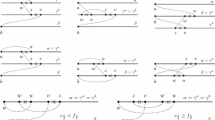Abstract
In the (1:b) component game played on a graph G, two players, Maker and Breaker, alternately claim 1 and b previously unclaimed edges of G, respectively. Maker’s aim is to maximise the size of a largest connected component in her graph, while Breaker is trying to minimise it. We show that the outcome of the game on the binomial random graph is strongly correlated with the appearance of a nonempty (b +2)-core in the graph.
For any integer k, the k-core of a graph is its largest subgraph of minimum degree at least k. Pittel, Spencer and Wormald showed in 1996 that for any k ≥ 3 there exists a constant ck, which they determine, such that p = ck/n is the threshold function for the appearance of the k-core in \(G \sim {\cal G}\left( {n,p} \right)\). More precisely, \(G \sim {\cal G}\left( {n,c/n} \right)\) has WHP a linear-size k-core for constant c>ck, and an empty k-core when c<ck.
We show that for any positive constant integer b, when playing the (1:b) component game on \(G \sim {\cal G}\left( {n,c/n} \right)\), Maker can WHP build a linear-size component if c > cb+2, while Breaker can WHP prevent Maker from building larger than polylogarithmic-size components if c< cb+2.
For the strategy of Maker when c> cb+2, we utilise known results on the k-core. For Breaker when c< cb+2, we make use of a result of Achlioptas and Molloy (sketching its proof) that states that after deleting all vertices of degree less than k, and repeating this step a constant number of times, G is WHP shattered into pieces of polylogarithmic size.
Similar content being viewed by others
References
D. Achlioptas and M. Molloy: The solution space geometry of random linear equations, Random Structures and Algorithms 46 (2015), 197–231.
M. Bednarska and Tomasz Łuczak: Biased positional games and the phase transition, Random Structures and Algorithms 18 (2001), 141–152.
J. Beck: Combinatorial Games: Tic-Tac-Toe Theory, Cambridge University Press, New York, 2008.
B. Bollobás: A probabilistic proof of an asymptotic formula for the number of labelled regular graphs, European J. Combinatorics 1 (1980), 311–316.
V. Chvátal and P. Erdős: Biased positional games, Ann. Discrete Math. 2 (1978), 221–228.
F. Chung and L. Lu: The diameter of sparse random graphs, Advances in Applied Math 26 (2001), 257–279.
J. Cain and N. Wormald: Encores on cores, Electronic J. Combinatorics 13 (2006), P81.
A. Ferber, R. Glebov, M. Krivelevich and A. Naor: Biased games on random boards, Random Structures and Algorithms 46 (2015), 651–676.
A. Frieze and M. Karoński: Introduction to random graphs, Cambridge University Press, 2015.
P. Gao: Analysis of the parallel peeling algorithm: a short proof, arXiv:1402.7326
H. Gebauer and T. Szabó: Asymptotic random graph intuition for the biased connectivity game, Random Structures and Algorithms 35 (2009), 431–443.
D. Hefetz, M. Krivelevich, M. Stojaković and T. Szabó: Global Maker-Breaker games on sparse graphs, European J. Combinatorics 32 (2011), 162–177.
D. Hefetz, M. Krivelevich, M. Stojaković and T. Szabó: Positional Games, Oberwolfach Seminars, vol. 44, Birkhäuser Basel (Springer), 2014.
D. Hefetz, M. Mikalački and M. Stojaković: Doubly biased Maker-Breaker Connectivity game, Electronic J. Combinatorics 19 (2012), P61.
R. Hod and A. Naor: Component games on regular graphs, Combinatorics, Probability and Computing 23 (2014), 75–89.
S. Janson and M. J. Luczak: A simple solution to the k-core problem, Random Structures and Algorithms 30 (2007), 50–62.
J. Jiang, M. Mitzenmacher and J. Thaler: Parallel peeling algorithms, ACM Trans. Parallel Comput. 3 (2016), #7, 1–27.
A. Lehman: A solution of the Shannon switching game, J. Soc. Indust. Appl. Math. 12 (1964), 687–725.
T. Łuczak: Size and connectivity of the k-core of a random graph, Discrete Math. 91 (1991), 61–68.
T. Łuczak: Sparse random graphs with a given degree sequence, in: Random Graphs: Volume 2 (A. Frieze and T. Łuczak, eds.), 165–182, John Wiley & Sons, 1992.
M. Molloy and B. Reed: A critical point for random graphs with a given degree sequence, Random Structures and Algorithms 6 (1995), 161–180.
C. St. J. A. Nash Williams: Edge-disjoint spanning trees of finite graphs, J. London Math. Soc. 36 (1961), 445–450.
B. Pittel, J. Spencer and N. Wormald: Sudden emergence of a giant k-core in a random graph, J. Combinatorial Theory Series B 67 (1996), 111–151.
P. Prałat, J. Verstraëte and N. Wormald: On the threshold for k-regular subgraphs of random graphs, Combinatorica 31 (2011), 565–581.
O. Riordan: The k-core and branching processes, Combinatorics, Probability and Computing 17 (2008), 111–138.
M. Stojaković and T. Szabó: Positional games on random graphs, Random Structures and Algorithms 26 (2005), 204–223.
W. T. Tutte: On the problem of decomposing a graph into n connected factors, J. London Math. Soc. 36 (1961), 221–230.
Acknowledgement
The authors are grateful to the anonymous referee who pointed out that Theorem 1.4 was already proved in [1], and for their careful reading and many helpful remarks.
Author information
Authors and Affiliations
Corresponding author
Additional information
Research supported by Len Blavatnik and the Blavatnik Family foundation.
Research supported in part by USA-Israel BSF grant 2018267, and by ISF grant 1261/17.
Research partially supported by NWO grants 639.031.829, 639.032.529 and 612.001.409.
Research supported by the Australian Laureate Fellowships grant FL120100125.
Rights and permissions
About this article
Cite this article
Hod, R., Krivelevich, M., Müller, T. et al. Component Games on Random Graphs. Combinatorica 42 (Suppl 1), 1189–1229 (2022). https://doi.org/10.1007/s00493-022-5036-9
Received:
Revised:
Published:
Issue Date:
DOI: https://doi.org/10.1007/s00493-022-5036-9



